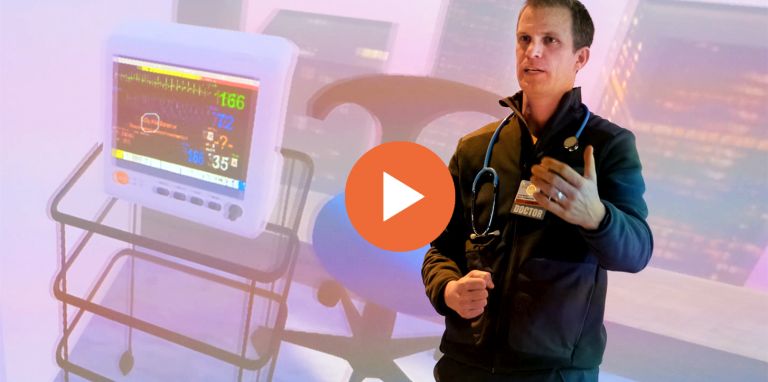Breadcrumb
Pacific leads transformation of dental students’ learning
Professors at the Arthur A. Dugoni School of Dentistry in San Francisco are collaborating with the Cube, University of the Pacific’s innovation and technology center on the Stockton Campus, to create groundbreaking virtual reality simulations that could change the future of dental education.
The three virtual and augmented reality programs are among the first in dental education.
“The simulation education in the health care environment is a multi-billion-dollar industry across health care, and dentistry has not stepped into that,” said Assistant Professor Jesse West Manton. “University of the Pacific could be the first in dentistry to take that leap.”
Manton, a certified health care simulation educator, is designing one of the programs—an emergency simulator—with the Cube’s Digital Projects Manager Keely Canniff ’20.
Manton reached out to Canniff after learning about the Cube’s resources, which include virtual reality development.
“It took us over a year to build this high-fidelity dental office from a blank, white square room, which has never been done before in any dental school in the United States, if not the world,” Manton said.
Manton compared the program to a flight simulator, giving students critical experience treating emergency patients. The virtual space is set up to look like an operatory room with a patient showing varied signs of distress that students must identify and react to.
“You get a really in-depth view of what's going on,” Canniff said. “You can pick up objects and interact with the tools.”
The scenarios are designed to closely replicate situations students will see in the future with real patients. “These students will save lives in the future because of this training,” Manton said.
They have already seen results. Recent graduate Danika Lund ’22 played the simulation as part of a beta test and relied on the experience during a real-life emergency in Dugoni’s clinic last month. Lund overheard another student describing a patient’s erratic behavior and stepped in to help.
“It was all because of those trainings,” Lund said. “That gave me the confidence to calmly assess the situation, evaluate the patient's medical history, put together the puzzle of what was happening with this patient and then treat accordingly.”
A research project is being developed to study the effects of using the simulation. If results are favorable, Manton plans to implement the technology in the upcoming academic year for about 180 students in the Doctor of Dental Surgery and International Dental Studies programs.
Delivering local anesthesia
Another program Canniff is working on with Assistant Professor Mustafa Radif gives students a space to practice delivering local anesthesia, using touch controllers to virtually pick up medical supplies and use them on a patient.
“This is the future,” Radif said. “We know that the new generation is more engaged with graphics and video games. The idea is how can we make it more engaging to different learning styles and preferences that students have.”
Development has advanced for nearly a year with students providing input throughout the design process. “It’s a collaborative team effort,” Radif said.
The program will be used for the first time in August with a small cohort in the dental hygiene program.
Another component, expected to be rolled out at a later date, gives students a three-dimensional view of head and neck anatomy to identify nerves, muscles and bones, which Associate Professor Bernadette Fa is collaborating on.
“I am working to develop a scavenger hunt with Keely. Students are shown a question and then have to go into the patient’s virtual head to find the correct landmarks,” Fa said. “The idea is to help them understand why they would need to go into that area of the mouth.”
It will not replace hands-on experience, but Fa sees it as an added resource providing a different perspective.
Root canal anatomy
Dental students learning about root canal anatomy will have a valuable tool with an augmented reality application in the works by Clinical Assistant Professor Gordon Lai.
“Root canal anatomy can be very complex and very hard to visualize based on 2D x-rays or 2D images in a lecture format,” Lai said. “I decided there was probably a better way to showcase to students how complex this anatomy can be.”
The app, which is still in the initial design phase, will allow students to view 3D models, zoom in and rotate the teeth using a smartphone.
“I have had these ideas before, and the hardest part was the technology expertise,” Lai said. “When I found out other dental faculty were working on projects with the Cube, I realized, ‘wow, I've had this asset all along.’”
Along with virtual reality development, the Cube, which is based in the William-Knox Holt Memorial Library and Learning Center, supports innovation among faculty, staff and students with 3D printing, drones, video production and more.
“We have robust resources that can be used by faculty,” Canniff said. “They come in with these amazing ideas, and we collaborate to make them come to life.”






